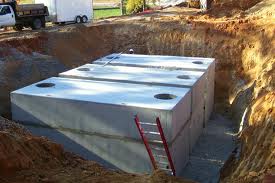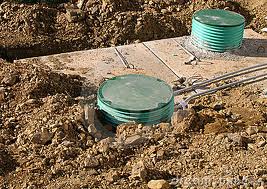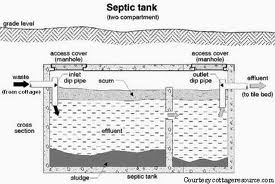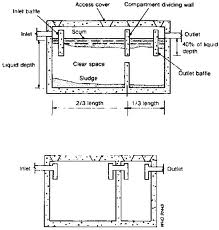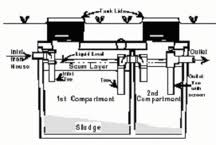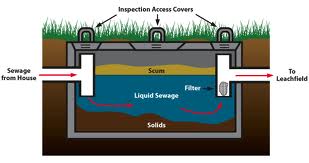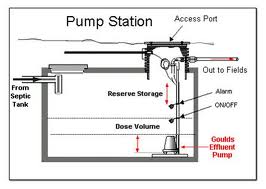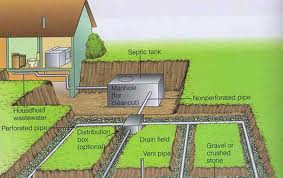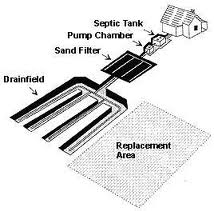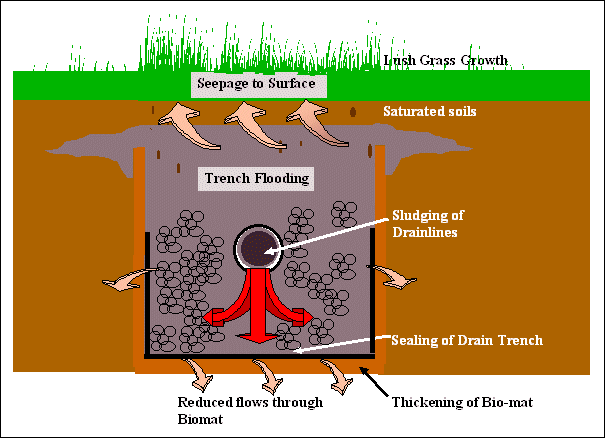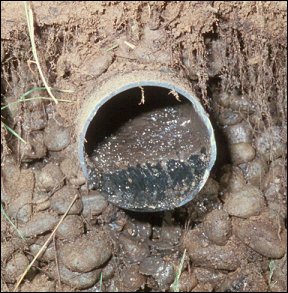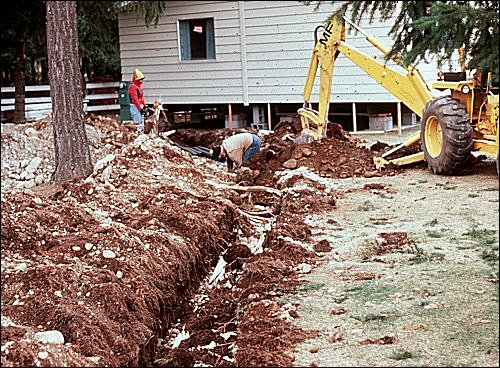Speak to a professional today!
Contact usHomeowner Septic Education
New information is added to this page monthly…. Please check back frequently for new and updated Septic System Information
How the septic system works
A septic system has two main parts: The Septic Tank and a Drainfield.
Septic Tanks
All conventional Septic Tank Systems have a Septic Tank, which is usually a large buried rectangular or cylindrical container made of concrete, fiberglass or polyethylene. Wastewater from all the homes plumbing lines, drain into the Septic Tank. Heavy solids settle to the bottom where bacterial action produces digested sludge and gases and we call this the Sludge Level. Lighter solids that float such as grease, oils and fats, rise to the top and form a scum layer and we call this the Scum Layer. Septic Tank Systems constructed before 1975 in King County usually have single compartment tanks (See our Locating & Digging Page for details). Homes that were built from 1975 – 1980 and on are usually two compartment Septic Tanks. This is important to know when having the Septic Tank pumping and cleaning done, as both compartments of a two-compartment tank need to be pumped as well as inspecting and cleaning the inlet and outlet baffles.
Two-Compartment septic tanks:
Solids that are not decomposed remain in the septic tank. If they are not removed by pumping the Septic Tank on a regular basis (every 3 – 5 years), the solids will continue to accumulate until they reach the outlet baffle and flow into the drainfield lines. This eventually leads to drainfield plugging and drainfield failure. The first signs may be slow draining fixtures, however the system may fail by discharging sewage effluent to the ground or back-up into the house as well (see below.)
Single compartment septic tanks:
Most septic tanks need to be pumped every 3-5 years, depending on the tank size, the amount of solids entering the tank and the habits of the users. The only sure way to know is to have the septic tank inspected annually. By measuring the sludge and scum layer thickness it can be determined when the tank needs to be pumped. The septic tank should be pumped whenever: the bottom of the scum layer is within 3 inches of the bottom of the outlet baffle or the top of the sludge layer is within 12 inches of the bottom of the outlet fitting (See below).
Wastewater leaving the septic tank is a liquid called effluent. While it has received some treatment in the septic tank it is still unpleasant smelling and contains disease organisms, organic wastes and other pollutants. This effluent requires proper treatment and disposal otherwise there can be significant environmental and public health problems. Discharging effluent onto the ground or into surface and ground water is against Washington State Law and King County Board of Health Codes.
Pump tanks:
Some system types in addition to a septic tank have a pump tank. This pump tank contains a sewage effluent pump, control floats, and a high water alarm. The control floats are set so that a specific volume of effluent is sent to the drainfield. This specific amount is referred to as a dose. When the effluent in the pump tank rises to the level of the “on” float the pump is activated and pumps the level of the effluent down until it reaches the “off” float setting (See Diagram 3 below.)
Should the “on” float fail to activate the pump or should the pump itself fail the level of effluent in the pump tank will continue to rise in the pump chamber. When this level reaches the alarm float an audible and visual signal will be activated. The location of the alarm device should be known by the homeowner (see your as-built information for details). The alarm device is commonly located under the kitchen sink or in the garage. Once this alarm is activated there is some emergency storage space available in the pump tank before the system actually over flows or backs up into the house. The audible signal can be deactivated but this will not solve the problem. You should immediately begin emergency water conservation measures and call a qualified repairperson (PDF) or contact the Eastgate Health District Office at (206) 296-4932 for more information.
Drainfields:
The drainfield is where liquid from the septic tank flows through pipes in your yard for final treatment by organisms in the soil. Grass and/or shallow-rooted plants are the best covers for your drainfield. See Landscaping tips with a septic system for more information.
Don’t park cars and trucks on the drainfield or septic tank. Also, don’t install driveways, patios, carports, decks, storage sheds, sports courts, landscaping plastic, and/or allow animals to graze. These activities pack soil and may lead to pipes breaking.
Your yard should also have a “reserve area” which is where your replacement drainfield will be located if your drainfield fails.
What to do if you have a septic system failure
All septic systems have a limited life expectancy so one can expect that they will fail at some point in time. Failing septic systems can expose you, your family, pets and your neighbors to sewage. Sewage contains pathogens and viruses that can cause disease. Sewage can also contaminate ground and surface water possibly polluting wells, rivers, streams or lakes near your home.
Failure warning signs:
* Bad odors around the drainfield area especially after heavy water use or rainfall
* Very wet spots with lush green grass growth over the drainfield or septic tank areas
* Standing water in the drainfield area
* Plumbing or septic tank back-ups
* Slow draining fixtures
* Gurgling sounds in the plumbing system
Drainfield Trench with Bio-Mat
Drainfield line full of sludge
Surfacing Sewage due to Trench Failure….. No Fun!
Open Drainfield Trench during Septic System Repair
Take action
If you think your Septic System is failing, please contact our office to schedule a service call with our Master Installer to confirm that there actually is a Septic System failure, the location and possible cause of the failure. We will also propose a repair solution. Remember: all septic system repairs require a repair permit from Public Health – Seattle & King County.
* A-1 Environmental ‘s certified Installer (Darren McCullough) is usually the first and best person to contact to investigate the problem but a licensed Designer (see our Designer) or qualified professional Engineer is also available.
* A-1’s certified Septic Tank Pumper/Sludgehauler (Darren McCullough) can inspect the septic or pump tank to investigate causes of septic system backups or slow draining fixtures. Darren is also a Certified Master Installer and able to complete the repair process for you if the septic system is failing.
* All septic system repairs require an approved repair proposal and a repair permit from Public Health – Seattle & King County. Darren McCullough of A-1 Environmental is a KC Master Installer and can submit the Septic repair Proposal and obtain the Permit to complete the Septic System Repair.
* A failing septic system may not have to be replaced with a new system. Our Master Installer, Darren McCullough, can advise you on your repair options.
* Pumping a failing system is only a temporary solution. While it may be necessary to have the tank pumped during the repair process, pumping the Septic Tank alone will not correct a failing septic system.
* Contact the A-1 Environmental Septic System Services for assistance and advice at 425-861-6978 or email at Info@A1Environmental.net
Cleaning indoor sewage spills
Thorough cleaning of indoor sewage spills is necessary to protect people — especially small children — from harmful bacteria and viruses. Clean-up should begin as soon as possible to reduce the risk of exposure to sewage.
* Keep children and pets out of the area until clean-up has been completed.
* Wear rubber gloves and boots.
* Wash your hands thoroughly and launder clothes separately after completing the clean-up.
* Remove all furniture, loose rugs, and so on from the area.
* Saturated wall-to-wall carpeting (and the pad) usually cannot be adequately cleaned. They should be removed, wrapped in plastic, and taken to a transfer station or sanitary landfill. If you decide to keep the carpeting, hire a licensed carpet cleaning company to steam clean and disinfect the carpet.
* All hard surfaces, such as linoleum, hardwood floors, concrete, wood moldings, wood, and metal furniture, and on should be thoroughly cleaned with hot water and a mild detergent (dish detergent), and then rinsed with a bleach solution by mixing one tablespoon of liquid household bleach to one gallon of water. Let the surface air dry.
* Upholstered furniture, loose rugs, drapery, and so on should be professionally cleaned. Notify the cleaner of the problem.
* Remove and replace plaster, plasterboard, and lath that have been saturated and are soft to the touch. If the surface has been wetted, clean as you would a hard surface, but do not saturate the plaster.
* Clean sinks, dishwashers, and other plumbing fixtures that have had sewage back-up with detergent, and then rinse with the bleach solution.
* Disinfect clean-up mops, brooms, and brushes with the bleach solution.
* Increase air circulation to reduce odors and mold growth — open all windows and doors. The use of fans and heaters may speed this process.
425-861-6978 or email at Info@A1Environmental.net

